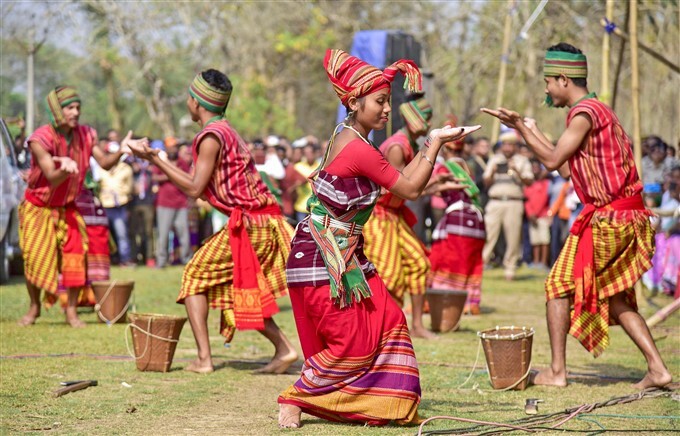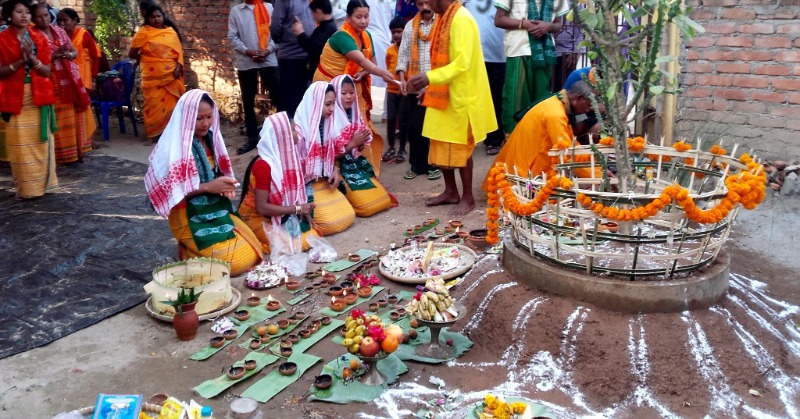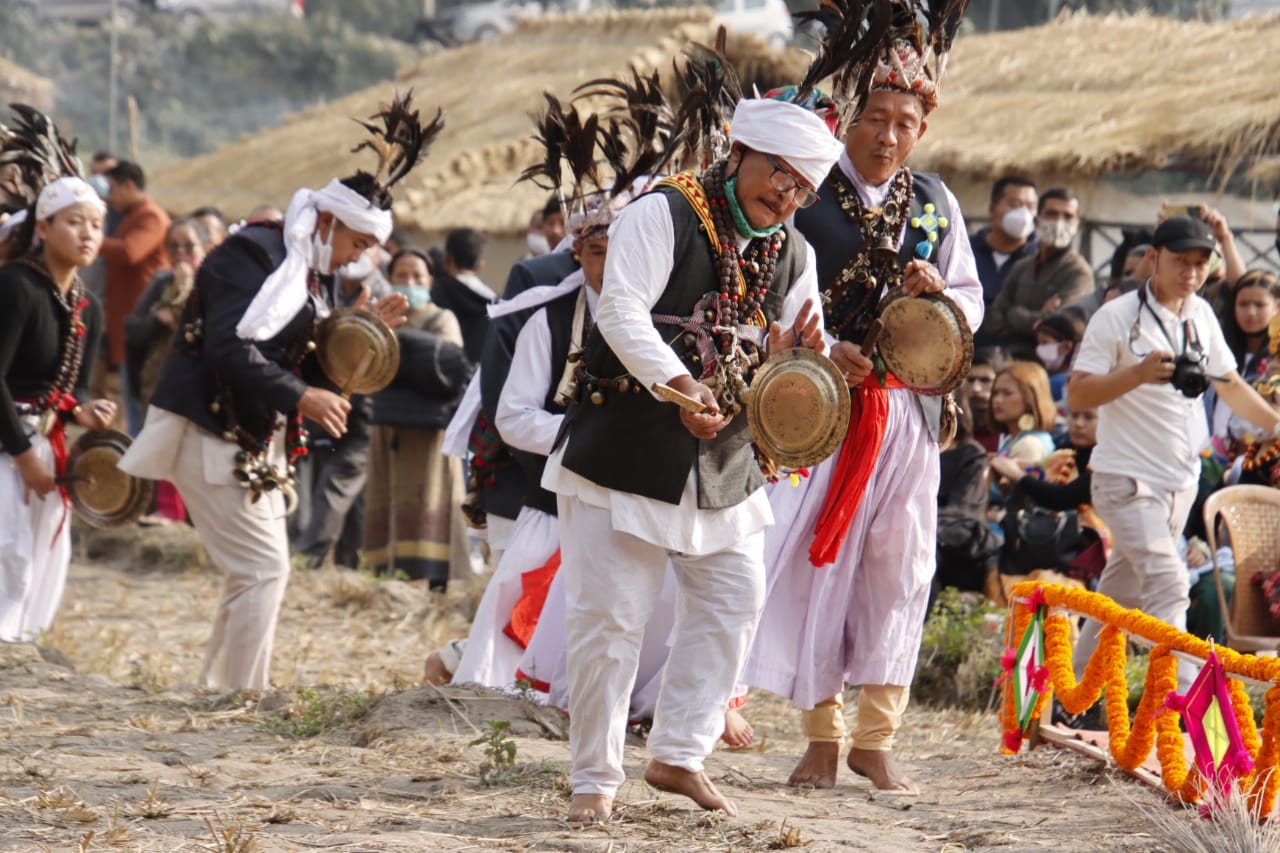Charumohan Rabha
Introduction
When we talk about the North- East of India then we mean that it refers to the states like Meghalaya, Mizoram, Nagaland, Manipur, Tripura, Arunachal and Assam. They are like the flowers of a garden. There are diverse mix of people and tribes living in this region. Among different tribes of Assam the Rabhas are considered very rich in their culture and tradition. Assam is the home to many tribes such as - the Naga tribe, the Bodo tribe, the Luchai tribes etc. Rabhas are the sub-tribe of Bodo Tribe.
Population description:
The Rabha live in Assam’s Goalpara, Kamrup, Drang (undivided), Garo Hills of the State of Meghalaya, Jalpaiguri, Kochbihar and Bardhaman in West Bengal and also in few neighbouring countries
Classification of the Rabha:
There are many ‘Khel’ (divisions) amongst the Rabha community. The divisions are- Rangdani, Maytari, Pati, Bitlia, Hana, Chunga, Tutla, Dahuri, Madahi, Kuchh etc. The actual Rabha society is formed from the first three divisions. Among the Rabha only three divisions viz. Rangdani, Maytari and Kochha, have their own scripts.
The Cultural Rites of Rabha People:
The Rabha people live by establishing society. People make a chief to rule the village in a society. The chief controls the society. The rules and regulations of the Rabha society are very tough. As such, the Rabha society follows their social obligations in a very strict manner. Polygamy is sternly disfavoured in the Rabha society. However, if the wife dies without leaving behind any issue, then the bereaved husband can remarry subject to the consent of his family and relatives.
Social and Cultural Rites:
Usually the Rabhas live in a village, which is controlled by the society. They are normally dependent on agriculture as a matter of tradition. So the Rabhas try to satisfy Baruna, the rain god, and worship him by offering ‘puja’. Actually when we refer to cultural rites we mean the various beliefs, religious rites, various festivals, the cultural functions or rites related to birth-marriage-death and the practice of traditional medicine.
First let us understand that the religion of the Rabha community is based on traditional belief. The Rabha may be called the worshippers of inanimate objects. They consider trees, big stones as god’s incarnation and worship them. The gods worshipped by the Rabha people are classified as good and bad directions, which means that the cultural practices by which all the members of the community are benefitted are good and the practices by which all people are not benefited or only a few individuals are benefitted are considered as bad or harmful.
In the olden days the Rabha lived in the hills to remain hidden from other communities. In those days in order to save themselves from ferocious animals and diseases they believed in the benevolence of gods and goddesses. As a result of such beliefs some of them worshipped their chosen gods and goddesses. The Rabhas are generally god fearing people. They are also afraid of ghosts and spirits. Therefore when someone amongst them suffered from vomiting, stomach disorder, dysentery etc they invoked God Kuber, who they believed will cure them. These rites were performed personally by the sick person. In order to dispel the bad omens causing harm to the society they worship goddesses. In order to get rid of cholera or small pox the they generally worship goddess Thakurani.
Beliefs and Religion:
The basis of religion of the Rabhas is the belief in the supernatural power of the unseen gods and cultural practices. It is difficult to say from when such beliefs came to be relied upon. The beliefs have been continuing since time immemorial and is handed down from one generation to other. It is believed that such superstitious beliefs emerged from the powers of nature, which they could see happening in their day to day lives.
From earlier days such superstitious beliefs prevailed in the Rabha society. The Rabhas believe in the superstition of the witch and evil spirits. According to their belief some males or females are capable of transforming themselves into witches by performing some evil rites and chanting some Mantras. Witch mantra is such a mantra by which one can acquire the power to harm other people. Belief in this type of witchcraft has tainted the good name of the Rabha community.
The beliefs of the Rabha community is based to a large extent on logical conclusions. It is admitted that superstition and lack of education has affected their world view. It can also be assumed that as they were far removed from the concept of modern science, they became victim’s black magic. Despite some progress in the field of education, 90% of the Rabhas continue to believe in social customs, superstitions and black magic. They fail to understands that belief without sound scientific backing is nothing but superstition. Weather forecast or treatment of the sick by resorting to black magic is not possible without some sound scientific backing. Even today snake bitten people are cured by the Bez (Traditional Snakebite healers) who chant Mantra to heal the snakebite victims. Astrology is also considered as superstition by a section of educated people, but none can deny that the conclusions of the Jyotis (Astrologer) practitioners are not always erroneous. Science is yet to discover the secret behind the traditional Jyotish practice. Hence, we cannot claim that tradition practices don’t have a scientific backing.
Some beliefs in vogue amongst the Rabhas are:
(1) When an earthquake occurs simultaneously, rain also comes.
(2) When ants come from up to down with eggs in a line then rain comes.
(3) When termite occurs then the weather becomes clear.
(4) If a dog sleeps on the floor of a house by digging hole then it indicates the harm of the owner.
(5) If a stray dog comes suddenly and starts to stay in a house then it signals harm to the owner.
(6) It is taboo to plant banana saplings in the month of Bhada.
(7) It is taboo to climb up to the roof at night.
(8) It is a bad omen to see a black cat at the time of travelling or while travelling.
(9) Women should not pluck betel leaves at the menstruation period.
(10) Betel creepers die if a person touches a dead body and after that plucks a betel leaf.
(11) We should not enter directly at home when we come from outside.
(12) We should wash up before entering home.
(13) Dogs should not be allowed to look at the person taking the meal.
(14) It is taboo for women to eat a joint banana. If someone eats then she will beget a twin baby.
(15) It is taboo to offer rice to any animal when he/she is taking rice.
It is worthy to be noticed that most of them are the expression of observational science. Examples:
(1) It is a bad omen that a dove falls in the courtyard in the morning.
(2) It is a good omen if a honeybee makes a beehive at home. It is a bad omen if a dove makes a nest at home dove falls in the courtyard in the morning.
(3) If a crow caws in the roof of the house it is a bad omen.
(4) If a vulture defecates at the roof of the house then it indicates the harm of the owner of the house.
(5) It is a bad omen if dogs or jackals bring bones from the jungle to the courtyard of a house.
(6) It is a bad omen to see a snake when travelling.
(7) If a person plants a banana sapling in the month of Bhada, it is a bad omen for him.
(8) It is a good omen to see an elephant when travelling.
(9) It is good if a person happens to see a dead body while travelling.
(10) If at the time of washing utensils some utensils fall from hand it indicates that guests will come.
(11) If anyone sees two magpies it is a good omen.
Some beliefs relating to religion, animals, birds, plants etc.
In the earlier times, although the Rabhas were living very close to nature yet sometimes the feeling of fear came to their minds. They did not know from where the fear came and so some beliefs took their roots in their minds. They therefore tried to tame the natural forces, especially the fire, water and air.
They resorted to worshipping their gods to tame the fearful nature of fire, water and air. To do so they devised Puja (Worship) rituals and created Mantras (chant). In this exercise a group of people undertaking the Puja rituals emerged and were socially acknowledged to perform the puja rituals to appease the natural forces such as fire, water and air as gods.
Thereafter the Rabhas gradually started to worship trees, creepers, naturally formed stones, forests, snakes etc. There is a saying that struggle teaches people the art of survival. If some one is bitten by a snake then people started to worship the snake god in order to get rid of the effects of its venom.
It is worthy of mention here that the Rabhas are cultivators. So, in order to increase the fertility of the cultivable land, they celebrate the Baikho Puja festival. The songs sung at that time are based on erotic love songs. Baikho Puja is sometimes celebrated for a week. Alongside the religious activities, the Rabhas also enjoyed song, dance and music. In accordance with the style and norms of the festival the young boys and girls sing ‘Sathar song’ and dance ‘Sathar dance’. Musical instruments like Dhak (kham), Tal, Flute, horn, trumpet etc. are played as accompaniment of Sathan song and dance.
The Features of Rabha Social System
The social system of the Rabha community is very tough. As a part of the social system they don’t tolerate flouting of social norms. The Rabhas cannot either be called patriarchal or matriarchal society. The ‘barai’ of the mother is the ‘barai’ of the son and the father’s property is owned by the son. But the property of the mother is not the property of the son. Daughters inherit mother’s property. Among the Rabhas, marriage is prohibited among the same descent of mothers. The special feature of the Rabha community is that the women are treated as equal as the place of men.
Marriage, Death and Death Ritual:
The specialities of Rabha marriage are-(1) Bhari Sing, (2) Nokdhange, (3) Jangui Dhangkai can marry. In the marriage the Rabhas do not need a Brahmin to perform the ceremony. In some areas, in the name of the bride and the bridegroom they dedicate a rooster to god Richi. The rooster’s head is cut and kept and dispose the other part of the body as they like. After the sacrifice of the rooster the work of the marriage begins. In case of the above three marriages, except the Jangui Dhangkai (if the bridegroom stays at the bride’s house after marriage) the other two marriages are solemnised at the bridegroom’s house. In fact, instead of the rooster cutting ritual, now-a-days the hom-yajna (ritual in front of the sacred fire) is performed in order to reform the marriage system. At the time of marriage the bride is given to sit at the right side of the bridegroom.
Birth, marriage and death are three big events in a person’s life. Death is inevitable. Nobody has the power to stop death. At the time of someone’s death the Rabhas dispose the dead body in two ways- either they bury it or cremate it. After cremation and collection of the ashes a small hut is made and coloured clothes are hung up over it. Rabha people believe that in the cremation ground the departed soul lives for many days. So they give meals for one week. The rite after the death of a person is called farkanti by Rabha people.
The meals, liquor etc. are offered at the time of farkanti by weeping and playing with ‘Taal’ (flat metal dish used as musical instrument). The sound of weeping is very sad. They cry as if the leaves of the trees are also feeling sad and begin to fall. The weeping of the Rabha people at that time is very significant. At the time of farkanti the Rabha people dance and sing farkanti song and dance. The dance is known as Fousakai and the song is known as Chai. In farkanti liquor (alcohol) is offered. During the farkanti rites, games and sports, and humorous songs etc are undertaken.
In conclusion it may be said that the cultural aspects of the Rabha in regard to farkanti rites are very bright. Folk culture of farkanti rites need to be preserved. To discuss culture we need to understand many things. Construction of houses, usual tools, things, fishing tackles, hunting weapons, cutting and weaving tools etc are matters to be discussed. If I discuss all these in length it will be too long so I leave them here. However when we talk about the tribal people of Assam, although they are identified differently, yet we see that culturally or linguistically the Tibet related people are more in number. Therefore if we do not notice the culture of the North-East people then it will be difficult to understand the others. When we talk about multi-culture, multi-lingual Assam, then it seems it is miniature India. To conclude it can be said from the quote of the preface of the edited book of Shri Pramod Chandra Bhatacharya, ‘Asamar Janajati’ (Tribals of Assam) where it is said that- ‘’ In the census of 1913, Mulan chahab (sir) told Assam as the heaven of linguists.’’ In 1888 Reverend Andel also wrote in the same tune-’’ This region especially Assam can provide a glimpse of ray in the field of Anthropology and other comparative theory of linguistic; the multi lingual Assam is in fact a fertile and wide ground for the students of theory of language.’’






